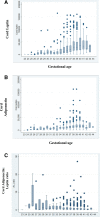Maternal and fetal factors affecting cord plasma leptin and adiponectin levels and their ratio in preterm and term newborns: New insight on fetal origins of metabolic dysfunction
- PMID: 37745945
- PMCID: PMC10035290
- DOI: 10.1097/PN9.0000000000000013
Maternal and fetal factors affecting cord plasma leptin and adiponectin levels and their ratio in preterm and term newborns: New insight on fetal origins of metabolic dysfunction
Abstract
Background: Understanding of maternal and fetal factors affecting leptin, adiponectin, and adiponectin:leptin ratio at birth may provide valuable insights into potential future risk of metabolic alterations and inform primordial prevention and precision nutrition strategies. The objective of this study is to identify maternal and fetal risk factors that affect leptin and adiponectin levels (markers of adiposity) and adiponectin/leptin ratio (a marker of dysfunctional adipose tissue) at birth.
Methods: We studied mother-infant pairs in the Boston Birth Cohort. Cord blood was collected at birth. We used student t- tests to compare log normalized cord leptin and adiponectin levels. Regression analysis was performed to examine the association of maternal and fetal factors with leptin and adiponectin levels and adiponectin:leptin ratio at birth in both term and preterm infants.
Results: We analyzed 1012 infants (245 preterm). Both cord leptin and adiponectin were higher in term infants than preterm infants (10.2 ± 0.9 vs. 9.2 ± 1.3, P < 0.0001 and 9.5 ± 0.7 vs. 8.9 ± 0.8, P < 0.0001, respectively). Cord leptin was higher for Black infants (10.1 ± 1.1 vs. 9.9 ± 1.2; P < 0.001) although Black (ref: non-Black) infants had lower cord adiponectin levels (9.3 ± 0.8 vs. 9.5 ± 0.7; P = 0.01). Ratio of adiponectin to leptin (log normalized) was higher in preterm infants (-0.24) vs. term infants (-0.69). On regression analysis, cord leptin was positively associated with longer gestational age (GA), birth weight z score, Black race, maternal overweight and obesity, gestational diabetes and pregestational diabetes mellitus and negatively associated with male sex. Cord adiponectin was positively associated with GA, birth weight z score and negatively with Black race and male sex. Adiponectin:leptin ratio was positively with male sex and negatively with GA, birth weight z score, Black race, gestational DM, pregestational DM and maternal overweight and obesity.
Conclusions: We identified several factors that affect leptin and adiponectin levels along with adiponectin-leptin ratio at birth beyond GA and birth weight which could also play an important role in influencing the trajectory of these hormones and future cardiometabolic outcomes. This knowledge can help tailor precision nutrition interventions.
Keywords: Adiponectin; Leptin; Prematurity.
Copyright © 2022 The Author(s), Published by Wolters Kluwer Health, Inc.
Conflict of interest statement
None.
Figures
Similar articles
-
Longitudinal Trajectory and Early Life Determinant of Childhood Adipokines: Findings From a Racially Diverse Birth Cohort.J Clin Endocrinol Metab. 2023 Jun 16;108(7):1747-1757. doi: 10.1210/clinem/dgad005. J Clin Endocrinol Metab. 2023. PMID: 36617246 Free PMC article.
-
Umbilical Cord Blood Adiponectin, Leptin, Insulin, and Ghrelin in Premature Infants and Their Association With Birth Outcomes.Front Endocrinol (Lausanne). 2021 Sep 30;12:738964. doi: 10.3389/fendo.2021.738964. eCollection 2021. Front Endocrinol (Lausanne). 2021. PMID: 34659122 Free PMC article.
-
Influence of birth-related maternal and neonatal factors on the levels of energy metabolism mediators in infants born at 32 or fewer weeks of gestation.J Matern Fetal Neonatal Med. 2023 Dec;36(2):2290919. doi: 10.1080/14767058.2023.2290919. Epub 2023 Dec 10. J Matern Fetal Neonatal Med. 2023. PMID: 38073078
-
Differential effects of type 2 diabetes and gestational diabetes on maternal and cord blood adipokines and newborn weight.BMC Pregnancy Childbirth. 2025 Mar 5;25(1):238. doi: 10.1186/s12884-025-07169-z. BMC Pregnancy Childbirth. 2025. PMID: 40045330 Free PMC article.
-
Adipokines underlie the early origins of obesity and associated metabolic comorbidities in the offspring of women with pregestational obesity.Biochim Biophys Acta Mol Basis Dis. 2020 Feb 1;1866(2):165558. doi: 10.1016/j.bbadis.2019.165558. Epub 2019 Oct 23. Biochim Biophys Acta Mol Basis Dis. 2020. PMID: 31654701 Review.
Cited by
-
Early Life Origins of Cardio-Metabolic Outcomes in Boston Birth Cohort: Review of Findings and Future directions.Precis Nutr. 2023 Sep;2(3):e00050. Epub 2023 Sep 27. Precis Nutr. 2023. PMID: 38283709 Free PMC article. No abstract available.
-
Hormonal Determinants of Growth and Weight Gain in the Human Fetus and Preterm Infant.Nutrients. 2023 Sep 18;15(18):4041. doi: 10.3390/nu15184041. Nutrients. 2023. PMID: 37764824 Free PMC article. Review.
-
High-Fat, High-Calorie Breast Milk in Women with Overweight or Obesity and Its Association with Maternal Serum Insulin Concentration and Triglycerides Levels.Children (Basel). 2024 Jan 23;11(2):141. doi: 10.3390/children11020141. Children (Basel). 2024. PMID: 38397253 Free PMC article.
-
Molecular pathways in placental-fetal development and disruption.Mol Cell Endocrinol. 2024 Feb 1;581:112075. doi: 10.1016/j.mce.2023.112075. Epub 2023 Oct 16. Mol Cell Endocrinol. 2024. PMID: 37852527 Free PMC article. Review.
-
Longitudinal Trajectory and Early Life Determinant of Childhood Adipokines: Findings From a Racially Diverse Birth Cohort.J Clin Endocrinol Metab. 2023 Jun 16;108(7):1747-1757. doi: 10.1210/clinem/dgad005. J Clin Endocrinol Metab. 2023. PMID: 36617246 Free PMC article.
References
-
- Gluckman PD, Hanson MA, Spencer HG. Predictive adaptive responses and human evolution. Trends Ecol Evol 2005;20(10):527–533. doi:10.1016/j.tree.2005.08.001. - PubMed
-
- Martin CR. Preventing bioenergetic failure in the preterm infant. Arch Dis Child Fetal Neonatal Ed 2016;101(2):F99–F101. doi:10.1136/archdischild-2015-308221. - PubMed
Grants and funding
LinkOut - more resources
Full Text Sources

